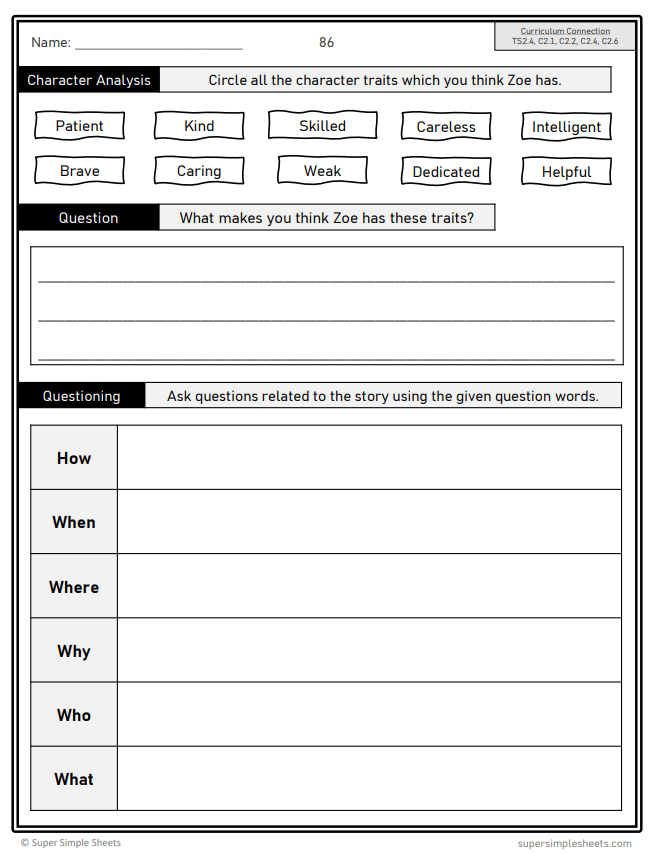Grade 2 - Reading Comprehension Unit - Alberta Language - Lesson/Workbook Bundle
Grade 2 - Reading Comprehension Unit - Alberta Language - Lesson/Workbook Bundle
Interested in a bundle? Shop below instead!
Couldn't load pickup availability
Grade 2 - Reading Comprehension Unit - Alberta Language Curriculum - Lesson/Workbook Bundle. This bundle was created to provide everything you need to teach the Grade 2 Reading Comprehension unit in the Alberta Language Curriculum.
With your purchase, you will receive lesson slides that follow the 3-Part lesson format, engaging your students from start to finish. You will also receive the workbook, which contains fun activities and worksheets for your students to demonstrate their understanding.
Workbook Details:
This resource covers all skills and procedures in the organizing ideas: Text Forms and Structures as well as Comprehension. The 276 pages teach the skills and procedures in these two curriculum areas.
We’ve included a variety of activities, including independent reading responses, group activities, assignments, experiments, exemplars, and hands-on activities to keep your students engaged.
Included in this resource are the organizing ideas below:
Text Forms and Structures: taught throughout the unit, with the use of 10 different blocks of text forms, including narratives, reports, poetry, comic strips, letters, procedural writing, book reviews, persuasive writing, and biographies.
Comprehension: as students learn about the text forms and structures of different types of writing, they will practice reading comprehension skills. They will read these different text forms, and use before reading, during reading, and after reading comprehension strategies – inferencing, visualizing, predicting, summarizing, making connections, and questioning. We have also included an independent reading response booklet.
In addition, we have included a full-year long range plan that outlines what concepts from the curriculum you will be teaching each week/block.
Some of the concepts covered:
- What are messages – purpose and audience?
- Before reading: comprehension strategies – activating prior knowledge and reasons for reading
- During reading: comprehension strategies – questioning, making connections, inferences, predictions, visualizing
- After reading: comprehension strategies – summarizing, making inferences, visualizing
- Letter writing – emails, formal and informal letters, writing with voice
- Cohesive ties – using linking words (conjunctions, pronouns, and transition words) in letter writing
- Narratives – use of literary devices: similes and consonance
- Perspective in narratives – first-person and third-person
- Narratives – sequencing multiple plots in a story and explaining cause and effect
- Folk tales and legends – heroes and heroines
- Story structure – characters, setting, plot, and events
- Reading strategies – chunk words, stretch words, and re-read texts
- Cross-curricular connections – science and social studies (water, growth of animals, changing families, etc.)
- Persuasive writing – using critical thinking skills to determine bias
- Using facts or opinions in persuasive writing
- Finding implicit and explicit evidence in persuasive texts
- Making inferences about persuasive texts
- What is procedural writing?
- Text features and text patterns of procedural writing – instruction booklets, how-to-guides
- Sequencing the steps in a how-to-guide
- Using graphics to enhance procedural texts
- Indigenous connection: how-to-guides for drawing Totem Poles, Igloos
- Text features in reports – index, glossary, timelines, headings, table of contents, charts, icons, etc.
- Reports on diversity, inclusion, and accessibility
- Use of infographics, timelines, maps, diagrams, and pictures in reports
- Literary devices used in poetry – similes and consonance
- Acrostic poems
- Assignment – examining poems written by Indigenous authors
- Reading different styles (voices) in book reviews
- Text features in comics, infographics, memes, and maps
- How images, graphics, and visuals contribute to biographies
- Text features in biographies – using a table of contents, icons, and indexes to understand a biography
- Biographies – Albert Einstein, Terry Fox, Margaret Atwood, Stephen Hawking: Table of Contents, Glossary
- Answer pages for all activities
Google Lesson Slides
Grade 2 - Reading Comprehension Unit - Google Lesson Slides - Alberta Language Curriculum. This resource is packed with all the lessons you need to teach the Reading Comprehension, Grade 2, Alberta Language Curriculum.
We have structured these lessons to follow the popular 3-Part Lesson format. By using these lessons, you will be provided with learning goals, discussion questions, relevant YouTube videos, interactive slides, exit cards, and more. Check out the variety of activities you'll receive below.
Part 1: Minds On!
- Learning Goals
- Discussion Questions
- Quotes
Part 2: Action!
- Interactive Activities
- Drag and Drop
- Fill in the Blanks
- Matching
- Drawing
- Writing
Part 3: Consolidation
- Exit Cards
- Quizzes
- Reflection
After purchasing this resource, you will be able to download a copy of this file to your Google Drive. From there, you can complete these lessons with your class, and/or assign these slides in Google Classroom.
Share















